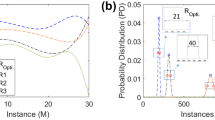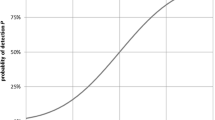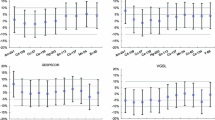Abstract
Time counting optimization in gamma-ray spectrometry was established using four HPGe detectors and four counting geometries. Deionized water samples with a mixed radioactive solution of 133Ba, 134Cs, 106Ru, 137Cs, 65Zn, and 60Co were prepared in volume from 0.1 to 3 L, and measured three times, for all detection systems, and for seven different counting times, ranging from 1,000 to 150,000 s. The obtained results were compared to the reference values from solutions with well-known activity concentrations samples, for minimum detectable amount (MDA) calculation. A counting time of 50,000 s was found to be generally sufficient to reach agreement between the preset and actual counting times.
Similar content being viewed by others
Avoid common mistakes on your manuscript.
Introduction
When designing detection systems for routine analysis of gamma emitters, several circumstances must be considered in order to optimize the system utilization with minimum counting time and acceptable detection limits. Gamma spectrometry is an analytical technique widely employed in quantitative radionuclide determination. The use of such systems is highly demanding, requiring time counting optimization according to each particular application, especially the minimum detectable amount (MDA) desired. When a large number of samples are processed in a short period of time, the question that arises is how to arrange the sample preparation and counting times in order to achieve the maximum information concerning the activities of potential radionuclides which can be obtained with the existing laboratory facilities. The methodology and the solution of the optimization problem are presented for the case of measuring several gamma-emitters in water samples.
In this study, “a priori” counting times as a function of the preset (MDA) are proposed for routine use. Initially, sample counting time was determined. This time is related to sample composition, radionuclide being analyzed, background radiation, geometry of detection flask and detection system (detector, shielding and associated electronics). Time counting optimization is also described, as an additional step in routine gamma-ray spectrometric measurements and automated spectral analysis which are used to control and assess the quality of the measurement and analysis.
Experimental
Optimization of the geometry and counting times
The optimization of the throughput of a laboratory, when the sample counting geometries and sample measurement times are related, is deeply important. The aim of the present work is to determine the counting times for a sequence of measurements required to meet the given minimum detectable activity and to express the counting times in terms of the spectrometer properties and counting physical geometry.
In 1968, Lloyd Currie at the National Bureau of Standards in the United States published a pioneering paper [1] on detection limits (LD) and related concepts. Currie stressed the importance of a clear definition of the term ‘‘detection limit’’, being the capability of an analysis method to detect the presence of a substance. He defined the concept of two limits: a critical limit, LC, which is part of the process and is used to concretely decide whether a signal is present or not in an actual measurement and a detection limit, LD, which qualifies the measurement process and is related with the sensitivity of the method. The critical limit, LC, is referred as an “a posteriori” limit, in the sense that is applied after the measurement and the detection limit, LD, is referred to as an “a priori” limit, reflecting the constraints of the methodology itself. Currie also introduced a third limit, the Determination Limit LQ [1], above which the precision is considered good enough for quantitative determinations.
According to Currie, LC may be defined as the level of the net signal above which the gross signal can be considered to statistically differ from the blank, or back-ground signal, and may be given as:
where σnet is the net signal uncertainty, B is the background count, and k is the coverage factor being employed. If k = 1.64, then we are 95% certain that, if LC is exceeded, a net signal is really present and thus the probability of making an error in assuming a signal has been detected where no signal is present—a Type I error or α is 5%.
Ld may be defined as a level of true net signal that, if present, will be detected with a given probability. In this case, we have to consider the possibility of not detecting the signal where one exists—a Type II error or β—and may be defined as:
where k′ is the coverage factor being employed.
Before considering Ld, the count times to use must be optimized. The available counting time is limited and criteria on how to share it between the sample itself and the background count should be established. However, for the routine work in our spectrometric laboratory, background spectra for several germanium detectors and sample geometries were already well determined and we need to be concerned only about samples counting times and MDA of the activities for radionuclides of interest.
Accordingly, the following procedure was established:
-
(a)
MDA calculation was performed by measuring with different detection systems, blank samples of deionized water setted in the most used samples counting geometries;
-
(b)
MDA values were checked by measuring, with the same detection systems as above, radioactive solutions with well-known activities setted in the same samples counting geometries;
-
(c)
“a priori” counting time was determined by using the expression:
where
- t e :
-
estimated counting time for a sample with unknown activity concentration;
- t k :
-
estimated counting time used for a sample with well-known activity concentration;
- MDA k :
-
Minimal Detectable Amount determined for the sample with well-known activity concentration;
- MDA e :
-
Minimal Detectable Amount determined for the estimated counting time t e
Measurements and calculation
The blank samples for background determination were prepared with deionized water. The radioactive samples were prepared from aqueous solutions with well known radionuclide concentrations, coming from National Intercomparison Runs of gamma-ray spectrometry measurements (Brazilian PNI), coordinated by IRD [2]. Both deionized water samples and radioactive samples were prepared in 1 and 3 L Marinelli beakers and 0.1 and 1 L polyethylene flasks, and measured for all detection systems, as shown in Table 1.
All the samples were measured three times, for all detection systems, and for seven different counting times, as follows: 1,000, 5,000, 10,000, 15,000, 50,000, 100,000 and 150,000 s. Spectra were analyzed with ORTEC WinnerGamma software [3] and MDA values for main gamma energies from some radionuclides of interest in radioecology (Table 2) were assessed. The obtained results were compared to the reference values from solutions with well-known activity concentrations samples, with their associated uncertainties, for minimum detectable amount (MDA) calculation.
Results and discussion
MDA values for the radionuclides of interest, calculated from the blank samples spectra, are shown in Fig. 1 for each detection spectrometry system. The reported MDA values are the mean values from each triple set of measurements. Those MDA values were checked as described in item 2.b above. One could observe that the “a priori” MDA values remained, in general, below the known concentration values, showing the consistency of the “a priori” AMD values, for all the counting geometries and counting times. Considering the laboratory activities in the quantification of radionuclides in environmental samples, “a priori” counting times were determined setting t k = 50,000 s, being a typical overnight measurement preset time. The results are shown in Fig. 2.
MDA values for the radionuclides of interest, calculated from the blank samples spectra for every detection system (See Table 1)
Calculated “a priori” counting times (s) using t
k
= 50,000 s, for every detection system (See Table 1). Counting Times (s): + 150,000; ♦ 100,000; * 50,000; × 15,000; ▲ 10,000;  5,000; • 1,000
5,000; • 1,000
Conclusions
The proposed methodology has the goal of optimizing the throughput of a laboratory when processing large batches of samples. The actual counting times obtained were in good agreement with the preset times for all the studied detection systems and counting geometries, suggesting that this methodology could be applied for a wide range of detection counting systems and sample geometries. Furthermore, a counting time of 50,000 s was found to be generally sufficient to reach agreement between the preset and actual counting times. Some care could be needed in applying these results when the composition and density of samples are significantly different from those used in the study reported here.
References
Currie, L.A.: Anal. Chem. 40, 586 (1968)
Tauhata, L., Vianna, M.E.C., Oliveira, A.E., Ferreira, A.C.M., Conceição, C.C.S.: Appl. Radiat. Isot. 56, 409 (2002)
InterwinnerTM 6.0 MCA Emulation, Data Acquisition and Analysis Software for Gamma and Alpha Spectroscopy IW-B32 2004, ORTEC, Oak Ridge, TN, USA. (2004)
Author information
Authors and Affiliations
Corresponding author
Rights and permissions
About this article
Cite this article
Nisti, M.B., Santos, A.J.G., Pecequilo, B.R.S. et al. Fast methodology for time counting optimization in gamma-ray spectrometry based on preset minimum detectable amounts. J Radioanal Nucl Chem 281, 283–286 (2009). https://doi.org/10.1007/s10967-009-0102-y
Received:
Published:
Issue Date:
DOI: https://doi.org/10.1007/s10967-009-0102-y






